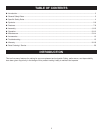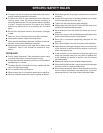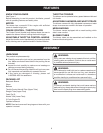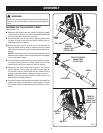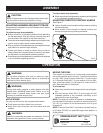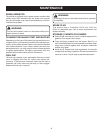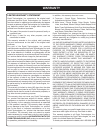
4
n
To reduce the risk of hearing loss associated with sound
level(s), hearing protection is required.
n
To reduce the risk of injury associated with contacting
rotating parts, stop the engine before installing or
removing attachments. Do not operate without guard(s)
in place. Always disconnect the spark plug before
performing maintenance or accessing any movable
parts.
n
Do not point the blower nozzle in the direction of people
or pets.
n
Never run the unit without the blower tubes installed.
n
Never place objects inside the blower tubes.
n
Never use for spreading chemicals, fertilizers, toxic sub-
stances, or any other hazardous chemical.
n
Always hold the blower in your right hand. Refer to the
“Operation” later in this manual for additional infor-
mation.
REFUELING
n Fuel is highly flammable. Take precautions when using
to reduce the chance of serious personal injury.
n
Empty fuel tank and restrain the unit from moving before
transporting in a vehicle.
n
To reduce the risk of fire and burn injury, handle fuel with
care. It is highly flammable.
n
Do not smoke while handling fuel.
n
Mix and store fuel in a container approved for gasoline.
n
Mix fuel outdoors where there are no sparks or flames.
SPECIFIC SAFETY RULES
n
Select bare ground, stop engine, and allow to cool before
refueling.
n
Loosen fuel cap slowly to release pressure and to keep
fuel from escaping around the cap.
n
Tighten the fuel cap securely after refueling.
n
Wipe spilled fuel from the unit. Move 30 feet away from
refueling site before starting engine.
n
Never attempt to burn off spilled fuel under any circum-
stances.
n Store fuel in a cool, well-ventilated area, safely away from
spark and/or flame-producing equipment.
n Store fuel in containers specifically designed for this
purpose.
n Only refuel outdoors and do not smoke while refueling.
n Add fuel before starting the engine. Never remove the cap
of the fuel tank or add fuel while the engine is running or
when the engine is hot.
n If fuel is spilled, do not attempt to start the engine but
move the machine away from the area of spillage and
avoid creating any source of ignition until fuel vapors
have dissipated.
n Replace all fuel tank and container caps securely.
n When draining the fuel tank, use an approved fuel storage
container while in a well-ventilated area.
n
Save these instructions. Refer to them frequently and use
them to instruct others who may use this tool. If you loan
someone this tool, loan them these instructions also.




